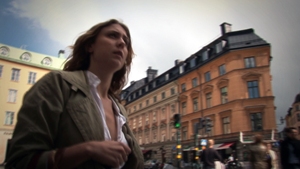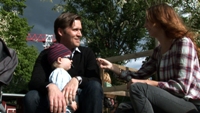|
Anna is from Sweden and lives in Paris, where she has done an Erasmus work practice at Cafebabel.com. She takes off to Stockholm, a city located within one of the most modern and advanced European societies when it comes to numerous social dimensions; she goes to Sweden. Men and women can here profit from some 18 months of paternity and maternity leaf – 18 months that they can share freely as a couple. The parental law demonstrates the emphasised importance to the relationship between the parent and the child and to its emotional education during the first years of its life.
The European Union is putting increased focus on gender equality. What benefits can the man profit from living in a society where men and women stand equal? Anna takes a look at the role that men play in Swedish society, a plausible prototype to European men?
      
Discover More
A European Man
Many have outlined the imageries of European identity, and numerous policies from Brussels have been launched to promote the debate and the creation of common imageries to European Citizenship.
The younger European population, the “Erasmus generation”, travel and meet with their fellow European citizens. The regional aspects of our geographic origin thus start to play a greater role than our national origins; to say today “I am European” is not that strange any more.
But what happens when we divide ‘the Europeans’ into two groups, two well-known groups of our society? – Men and Women.
The stereotyped imageries that we have of e.g. an Italian Gigolo, a Swedish Blondie, or a Spanish Senorita are still quite vivid when giving description to our European gender identities. But how accurate are these imageries, and how well do we know how you live life as a man or woman in France, in Poland or in Sweden?
We bring these questions to light as we address the question of gender equality in our European community.
Sweden is said to be the most equal country when it comes to gender issues and we often hear testimonies of the advancements of women’s’ rights in the Swedish society. But how has the role of the Swedish man changed alongside the evolvement of women’s rights. How does the Swedish man live life in Sweden, and could he be a new representational image of European Men?
We initiate the debate by seeking to meet “the Swedish man”, in contrast with other European masculine identities. What sort of responsibilities does a Swedish man have today, how does he reason upon gender equality and feminism? But also, how has the Swedish man gained rights and benefits alongside the new societal norms and laws created to assure a more equal community between men and women?
We also investigate where these advancements are sprung from, how they have been implemented and ultimately how they have changed Swedish norms of reflecting upon gender issues and how the everyday life is conducted in the most gender equal country in our European sphere.
To raise these questions is to raise a debate, a reflection and consciousness about our gendered conventions, often non-reflected upon in our daily European life.
We meet with a European Man.
Written by Anna Sennö
|